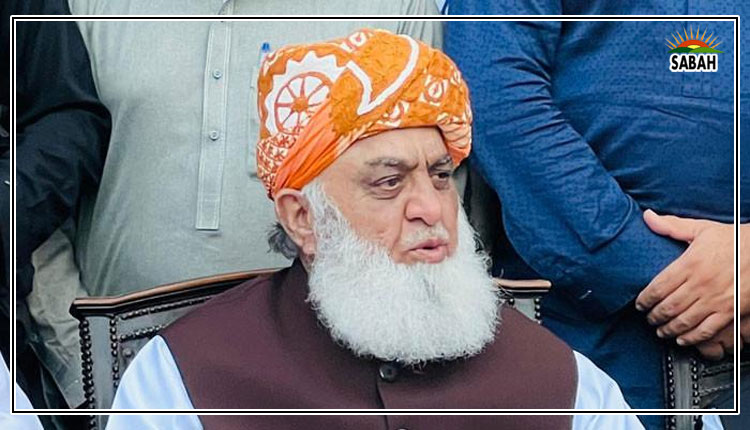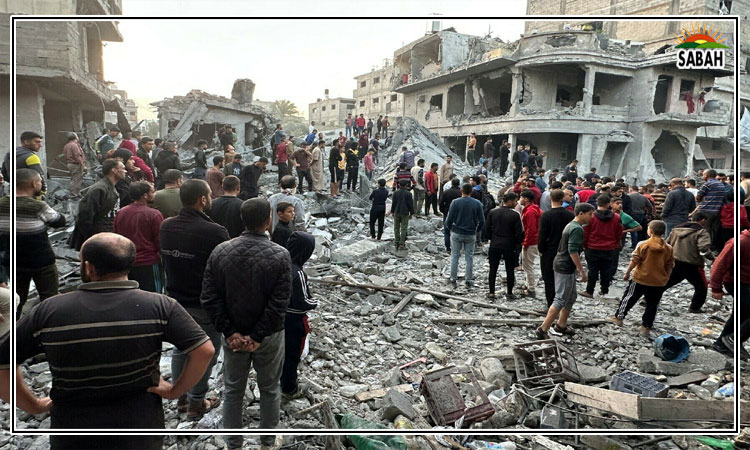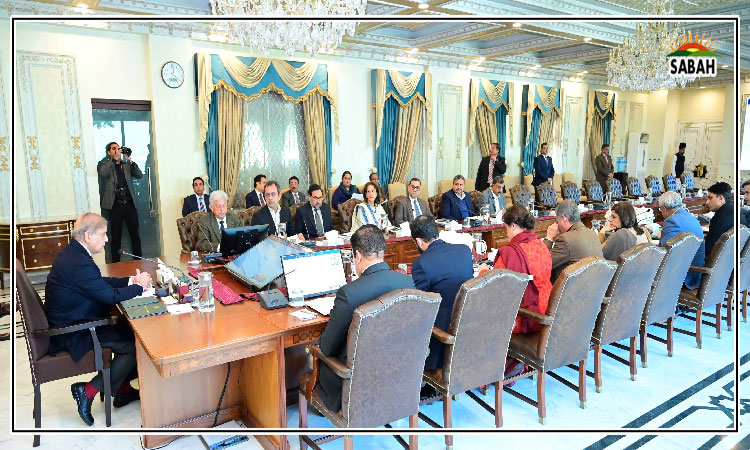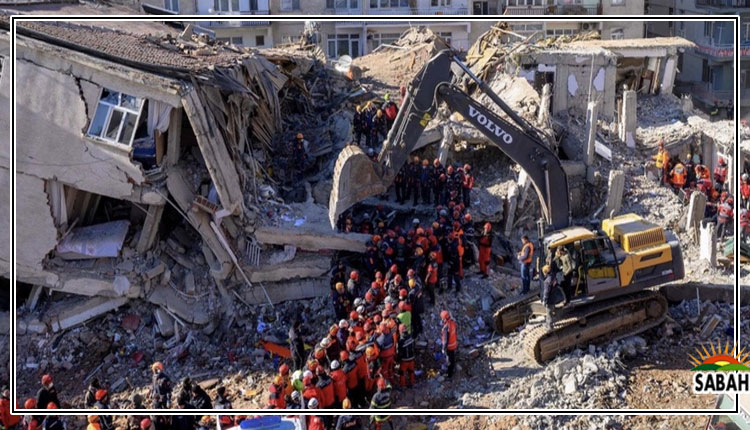Major earthquake of 7.8 magnitude strikes Turkey, Syria; over 1,300 dead, many trapped
DIYARBAKIR/ANKARA:, Feb 06 (SABAH): A powerful 7.8 magnitude earthquake rocked southeastern Turkiye and northern Syria early Monday, toppling hundreds of buildings and killing more than 1,300 people. Hundreds were still believed to be trapped under rubble, and the toll was expected to rise as rescue workers searched mounds of wreckage in cities and towns across the area.
On both sides of the border, residents jolted out of sleep by the pre-dawn quake rushed outside on a cold, rainy and snowy winter night, as buildings were flattened and strong aftershocks continued.
Rescue workers and residents in multiple cities searched for survivors, working through tangles of metal and giant piles of concrete. A hospital in Turkiye collapsed and patients, including newborns, were evacuated from a handful of facilities in Syria.
In the Turkish city of Adana, one resident said three buildings near his home collapsed. “I don’t have the strength anymore,” one survivor could be heard calling out from beneath the rubble as rescue workers tried to reach him, said the resident, journalism student Muhammet Fatih Yavus.
In the Turkish city of Adana, witnesses said they heard one person calling for help from beneath the rubble of a building. “I don’t have the strength to carry on,” the person cried. Further east in Diyarbakir, cranes and rescue teams worked at a mountain of pancaked concrete floors that was once an apartment building.
Farther east in Diyarbakir, cranes and rescue teams rushed people on stretchers out of a mountain of pancaked concrete floors that was once an apartment building.
The quake, felt as far away as Cairo, was centered north of Gaziantep, a Turkish provincial capital.
It struck a region that has been shaped on both sides of the border by more than a decade of civil war in Syria. On the Syrian side, the swath affected is divided between government-held territory and the country’s last opposition-held enclave, which is surrounded by Russian-backed government forces. Turkiye, meanwhile, is home to millions of refugees from that conflict.
The opposition-held regions in Syria are packed with some 4 million people displaced from other parts of the country by the fighting. Many of them live in buildings that are already wrecked from past bombardments. Hundreds of families remained trapped in rubble, the opposition emergency organization, called the White Helmets, said in a statement.
Strained health facilities and hospitals were quickly filled with wounded, rescue workers said. Others had to be emptied, including a maternity hospital, according to the SAMS medical organization.
“We fear that the deaths are in the hundreds,” Muheeb Qaddour, a doctor, said by phone from the town of Atmeh.
Turkiye sits on top of major fault lines and is frequently shaken by earthquakes. Some 18,000 were killed in powerful earthquakes that hit northwest Turkiye in 1999. The U.S. Geological Survey measured Monday’s quake at 7.8. At least 20 aftershocks followed, some hours later during daylight, the strongest measuring 6.6, Turkish authorities said.
Buildings were reported collapsed in a wide area extending from Syria’s cities of Aleppo and Hama to Turkiye’s Diyarbakir, more than 330 kilometers (200 miles) to the northeast. Nearly 900 buildings were destroyed in Turkiye’s Gaziantep and Kahramanmaras provinces, said Vice President Fuat Oktay. A hospital collapsed in the Mediterranean coastal city of Iskanderoun, but casualties were not immediately known, he said.
“Unfortunately, at the same time, we are also struggling with extremely severe weather conditions,” Oktay told reporters. Nearly 2,800 search and rescue teams have been deployed in the disaster-stricken areas, he said.
“We hope that we will get through this disaster together as soon as possible and with the least damage,” Turkish President Recep Tayyip Erdogan wrote on Twitter.
Countries from Taiwan to Russia to Germany offered to send help, whether medical supplies, search teams or money.
In Turkiye, people trying to leave the quake-stricken regions caused traffic jams, hampering efforts of emergency teams trying to reach the affected areas. Authorities urged residents not to take to the roads. Mosques around the region were being opened up as a shelter for people unable to return to damaged homes amid temperatures that hovered around freezing.
The quake heavily damaged Gaziantep’s most famed landmark, its historic castle perched atop a hill in the center of the city. Parts of the fortresses’ walls and watch towers were leveled and other parts heavily damaged, images from the city showed.
In Diyarbakir, hundreds of rescue workers and civilians formed lines across a mountain of wreckage, passing down broken concrete pieces, household belongings and other debris as they searched for trapped survivors while excavators dug through the rubble below.
In northwest Syria, the quake added new woes to the opposition-held enclave centered on the province of Idlib, which has been under siege for years, with frequent Russian and government airstrikes. The territory depends on a flow of aid from nearby Turkiye for everything from food to medical supplies.
The opposition’s Syrian Civil Defense described the situation there as “disastrous,” adding that entire buildings have collapsed and people are trapped under the rubble.
In the small Syrian rebel-held town of Azmarin in the mountains by the Turkish border, the bodies of several dead children, wrapped in blankets, were brought to a hospital.
The USGS said the quake was centered about 33 kilometers (20 miles) from Gaziantep. It was 18 kilometers (11 miles) deep.
At least 912 people were killed in 10 Turkish provinces, with more than 5,400 injured, according to Turkiye’s president. The death toll in government-held areas of Syria climbed to 326 people, with some 1,000 injured, according to the Health Ministry. In rebel-held areas, at least 150 people were killed, according to the White Helmets, though the SAMS medical organization put the toll at 106; both said hundreds were hurt.
In Damascus, buildings shook and many people went down to the streets in fear. The quake jolted residents in Lebanon from beds, shaking buildings for about 40 seconds. Many residents of Beirut left their homes and took to the streets or drove in their cars away from buildings, terrorized by memories of the 2020 port explosion that wrecked a large portion of the city.
Huseyin Yayman, a legislator from Turkiye’s Hatay province, said several of his family members were trapped under the rubble of their collapsed homes.
“There are so many other people who are also trapped,” he told HaberTurk television by telephone. “There are so many buildings that have been damaged. People are on the streets. It’s raining, it’s winter.”
The United States was “profoundly concerned” about the quake in Turkiye and Syria and was monitoring events closely, White House national security adviser Jake Sullivan said on Twitter.
“I have been in touch with Turkish officials to relay that we stand ready to provide any and all needed assistance,” he said.
“Our primary job is to carry out the search and rescue work and to do that all our teams are on alert,” Turkish Interior Minister Suleyman Soylu told reporters.
Tremors were also felt in the Turkish capital of Ankara, 460 km (286 miles) northwest of the epicentre, and in Cyprus, where police reported no damage.
“The earthquake struck in a region that we feared. There is serious widespread damage,” Kerem Kinik, the chief of the Turkish Red Crescent relief agency, told Haberturk, issuing an appeal for blood donations.
In Syria, President Bashar al-Assad held an emergency cabinet meeting to review the damage and discuss the next steps, his office said.












